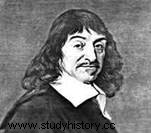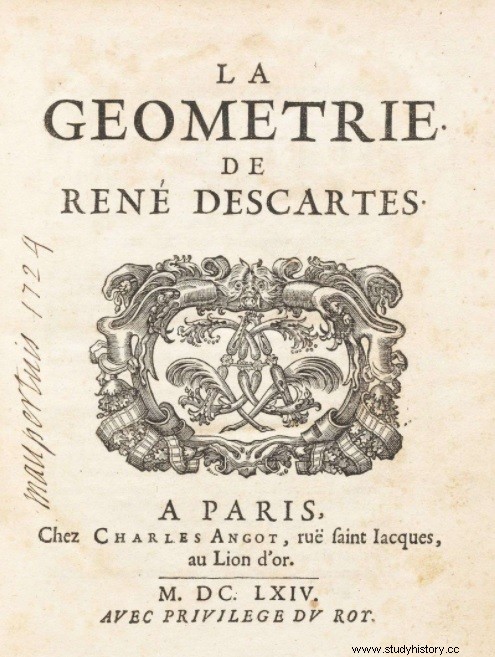 René Descartes (1596-1650) is a French philosopher, physicist and mathematician, theoretician of rationalism. Published in 1637, His Discourse on Method is his most important work. In mathematics, he developed algebraic writing and founded analytical geometry. Descartes will influence opposing philosophical currents, such as the mysticism of Malebranche or the rationalism of Diderot. He is one of the first modern thinkers and founders of philosophy, and will symbolically mark the end of Aristotelianism. A "Cartesian mind" will become an expression designating a rigorous and logical person in his thought.
René Descartes (1596-1650) is a French philosopher, physicist and mathematician, theoretician of rationalism. Published in 1637, His Discourse on Method is his most important work. In mathematics, he developed algebraic writing and founded analytical geometry. Descartes will influence opposing philosophical currents, such as the mysticism of Malebranche or the rationalism of Diderot. He is one of the first modern thinkers and founders of philosophy, and will symbolically mark the end of Aristotelianism. A "Cartesian mind" will become an expression designating a rigorous and logical person in his thought.
Short biography of René Descartes
Born March 31, 1596, Descartes is from La Haye-en-Touraine (now renamed Descartes). Coming from the upper middle class, he is the son of an adviser to the parliament of Rennes. Raised at the Jesuit college of La Flèche, he quickly distinguished himself for his taste for philosophy, mathematics and law. He obtained a law degree at the University of Poitiers but refused to pursue this path. He began a military career under the orders of the Dutchman Maurice de Nassau then Maximilian of Bavaria and took part in the first campaigns of the Thirty Years' War.
From 1625 to 1628, he frequented scientific and literary circles in Paris, but refused to settle there and returned to settle in the Netherlands, where he devoted himself to his work as a philosopher and scholar. he successively published there his Discourse on Method (1637), his Metaphysical Meditations (1641), his Principles of Philosophy (1644) and his Treatise on the Passions of the Soul (1648). Invited by Queen Christina of Sweden in 1649, he died shortly afterwards in Stockholm, leaving a rich and innovative work.
Cartesian thinking
Descartes' thought, known as "Cartesian", combines science and philosophy. For him, all the sciences are subordinated to a universal science:the mathesis universalis, the universal science of order and measurement. In 1637 he published the Discourse on the method (Discourse on the method for conducting one's reason well and seeking the truth in the sciences) , his most important work. In this famous Discourse, the French philosopher presupposes that all the sciences are subordinate to a universal science of order and measurement, the mathesis universalis.
 His approach stems from both metaphysical idealism and experimental materialism. This is how, in his famous Discourse, he developed “methodical doubt”. The cogito ergo sum formula (“I think therefore I am”) constitutes the starting point of all reflection and affirms the power of logical reasoning; it allows man to know the laws of nature and to describe the functioning of the world and of the human body. Descartes wrote many philosophical works {the Meditations; the Passions of the Soul, ...) and treaties of mathematics and physics {the Dioptics, the Meteors, the Geometry, the Treaty of the World, which, developing ideas close to those of Galileo, was not published because of the condemnation of the latter in 1633).
His approach stems from both metaphysical idealism and experimental materialism. This is how, in his famous Discourse, he developed “methodical doubt”. The cogito ergo sum formula (“I think therefore I am”) constitutes the starting point of all reflection and affirms the power of logical reasoning; it allows man to know the laws of nature and to describe the functioning of the world and of the human body. Descartes wrote many philosophical works {the Meditations; the Passions of the Soul, ...) and treaties of mathematics and physics {the Dioptics, the Meteors, the Geometry, the Treaty of the World, which, developing ideas close to those of Galileo, was not published because of the condemnation of the latter in 1633).
Cartesian thought has had a great influence on modern philosophy. Diderot, Pascal, Leibniz, Mallebranche and Spinoza were largely inspired by the work of Descartes to develop new issues and reflections.
A method declined in mathematics and geometry
The basis of the Cartesian method is the strict obedience to the rule of evidence:"never accept anything for true that I do not obviously know it to be so". Any rational scientific approach must begin with the simplest notions to arrive, by deductive way, at the most complex notions which depend on the first. Mathematics follows this method and is therefore the ideal model that must be applied to all sciences. Descartes imposes the use of the last letters of the alphabet to designate the unknown values (x, y, z) and of the first letters for the known values (a, b, c). It also introduces the superscript notation (x2) to express the power of a number.
 In geometry, his contributions are fundamental. It was he who established that Euclidean geometry is based on an arithmetic structure, that of real numbers. At the same time and independently of Pierre de Fermat, Descartes contributed to the creation of analytical geometry (which made it possible to associate equations with curves and geometric figures). It thus develops the Cartesian coordinates (abscissa and ordinate). In geometric optics, Descartes discovers the law of the refraction of light. In mechanics, it was still Descartes who first stated the principle of inertia.
In geometry, his contributions are fundamental. It was he who established that Euclidean geometry is based on an arithmetic structure, that of real numbers. At the same time and independently of Pierre de Fermat, Descartes contributed to the creation of analytical geometry (which made it possible to associate equations with curves and geometric figures). It thus develops the Cartesian coordinates (abscissa and ordinate). In geometric optics, Descartes discovers the law of the refraction of light. In mechanics, it was still Descartes who first stated the principle of inertia.
Main works of René Descartes
- 1618:Treatise on music
- 1628-1629:Rules for the direction of the mind
- 1633:Treatise on the world or light 1637 Discourse on - method (followed by Dioptrics, Meteors and Geometry)
- 1641:Metaphysical Meditations
- 1644:Principles of Philosophy
- 1649:The Passions of the Soul
To go further
- Discourse on Method, by René Descartes. Pocket GF, 2016.
- Metaphysical Meditations, by René Descartes. Paperback, 1990.
- Descartes:Biography, by Geneviève Rodis-Lewis. Calmann-Lévy, 1995.
